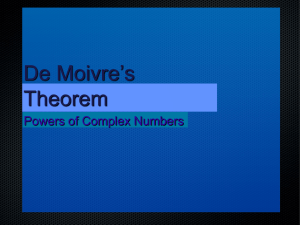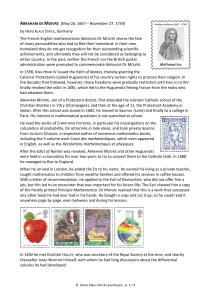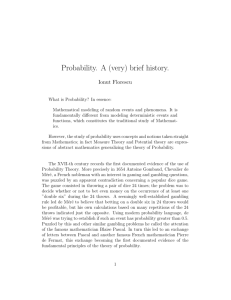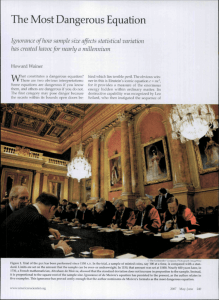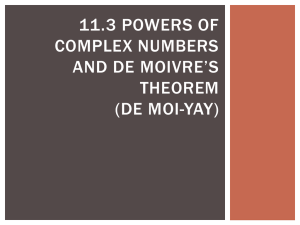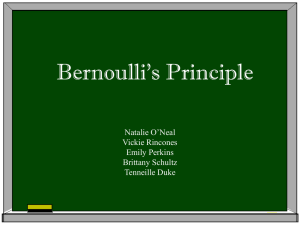De Moivre and Normal Distribution
advertisement
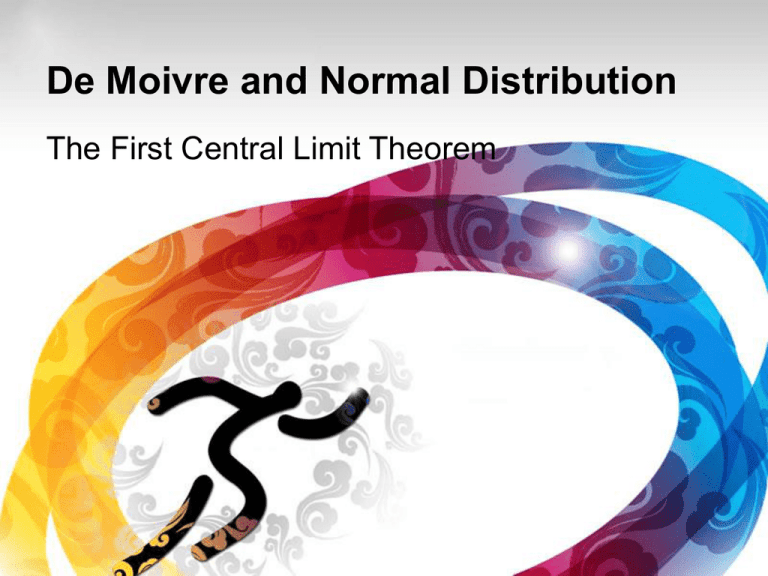
De Moivre and Normal Distribution The First Central Limit Theorem Central Limit Theorem • CLT states that, given certain conditions, the mean of a sufficiently large number of independent random variables, each with finite mean and variance, will be approximately normally distributed. • De Moirve-Laplace theorem is a special case of the CLT, a normal approximation to the binomial distribution, i.e. B(n, p) N(np, npq) Normal Distribution and Gauss Curve NSS Mathematics Curriculum Abraham de Moivre • • • • Abraham de Moivre 1667-1754 French mathematician a friend of Newton, Halley, Stirling Motive • Miscellanea Analytica (1730) ("On the Binomial a+b raised to high powers") began by quoting extensively from that portion of Ars Conjectandi where Bernoulli had first come to grips with the problem of specifying the number of experiments needed to determine the actual ratio of cases, within a given approximation. • The mathematical treatment was his own. • He began from the simpliest case, the symmetrical binomial, i.e. p = ½. Mathematical Tools • Newton • Walli 1 x x3 x5 x7 ln( ) 2( x 1 x 3 5 7 2 • Bernoulli ) 224466 1 3 3 5 5 7 c 1 c n n c c( c 1)(c 2) c c 1 c 3 n B n B n c 1 c 2 2 4 2 3 4 c( c 1)(c 2)( c 3)( c 4) B6n c 5 2 3 4 5 6 Theorem 1 Cnn/2 2 n 2 2 n [to compare the middle term with the sum of all terms] [when n = 2m] Proof ln Cnn / 2 2 ln n ln 2m Cm 2 2m ( 2m )! 2 2m m! m! 2m 1 2m 1 m 1 m 2 m 3 ln 2m m 1 m 2 m 3 m 1 2 1 2m m 1 m 2 m 3 m ( m 1) ln 2 ) 1 m ( m 3 m 2 m 1 m 1 2m 1 ln 2 1 m 1 3 2 1 1 1 m m m m m 1 3 2 1 1 1 1 m m m m 1 Proof 1 2 m ln 2 ln 1 1m 1 m (1 2m ) ln 2 1 ln 1 2m 1 2 m ln 1 3m 1 m 3 ln 1 1 1 3 1 1 5 1 1 7 2 ( ) ( ) ( ) 5 m 7 m m 3 m 1 2 1 2 2 1 2 2 ( )3 ( )5 ( )7 5 m 7 m m 3 m 3 1 3 3 1 3 5 1 3 7 2 ( ) ( ) ( ) 5 m 7 m m 3 m m 1 1 m 1 3 1 m 1 5 1 m 1 7 2 m ( m ) ( m ) ( m ) 3 5 7 1 m 1 m 1 m 1 m Proof (1 2m ) ln 2 1 1 1 2 ( ) ( m 1) 2 ( m 1) m 2 2 1 3 1 2( 1 3 ) ( m 1) 4 ( m 1) 3 B2 ( m 1) 2 3m 4 2 2 1 5 5 1 2( 1 5 ) ( m 1) 6 ( m 1) 5 B2 ( m 1) 4 B4 ( m 1) 2 5m 6 2 2 2 1 8 1 7 7 6 35 4 7 1 2( 7 ) ( m 1) ( m 1) B2 ( m 1) B4 ( m 1) B6 ( m 1) 2 7m 8 2 2 4 2 B B B 1 ( 2m ) ln(2m 1) 2m ln(2m ) ln 2 2 4 6 2 1 2 3 4 5 6 Proof 1 1 Note that 2m(ln(2m 1) 2m ln(2m)) 2m ln(1 ) 1 2m 4m B6 B2 B4 Also, ln 2 0.7739 1 2 3 4 5 6 Cm2m 1 ln ln 2m 1 0.7739 2 2m 2 2m Cm 0.7976 2 2m B n 2 2m 1 1 1 1 where ln B 1 ln 2 (Stirling) 12 360 1260 1680 Another Try 2 2 ( m!) 2 2 4 4 6 6 (2m)(2m) 1 lim lim 2 m 1 3 3 5 5 7 (2m 1)(2m 1) m (2m)! 2m 1 Cm2 m (2m)! 2 1 22 m 22 m m ! m ! (2m 1) m Cnn/2 2 n 2 2 n 2m 2 Theorem 2 Cm2 m 2 ln 2 m Cm n 2 [to compare the middle term with the term distant from it by an interval l] Proof Cm21m m 1 1m 1 2 m 1 3 m ln 2 m ln 3 1 2 Cm m 1 m 1 m 1 m 1 m 1 m 1 m 1 m m ( m ) ln( m 1) ( m ) ln( m 1) 2m ln m ln m 1 1 1 1 ( m 2 ) ln(1 ) ( m 2 ) ln(1 ) ln(1 ) m m m 1 2 1 2 ( m ) ln(1 ( m )( m 2 2 m n 2 m ) ( m ) ln(1 2 2m 2 m ) ( m )( ) m 2 2m 2 ) Corollary 2m m 2m C 2 2m m 2m C 2 e 2 n Note that p n 2 Pd n 2 1 2 2 2 e 2 n 2 e 2 n 2 n 2 , 2 npq 14 n 2 n 2 2 2 n 0 e 2 x 2 n 4 dx 2 n 1 n De Moirve : 2 inflectional points 2 2 0 / n e 2 x 2 dx Areas Within 1, 2, 3 Standard Deviations a 3h a 2 n 3h f ( x )dx f (a ) 3 f (a h ) 3 f ( a 2h ) f ( a 3h) 8 2 2 2 4 4 8 6 16 8 32 10 64 6 e 1 2 3 4 5 6 n 2n 6n 24n 120n 720n integrate between 0 and to get 2 3 4 5 8 7 16 9 32 11 2 3 4 5 3n 5 2n 7 6n 9 24n 11 120n Areas Within 1, 2, 3 Standard Deviations De Moivre Exact 1 0.682 688 0.682 689 2 0.954 28 0.954 50 3 0.998 74 0.997 30 Significance of √n • De Moivre introduced the term Modulus for the unit √n • accuracy increases as √n • Bernoulli had announced in Ars Conjectandi, even " the most stupid of men... is convinced that the more observation s have been made, the less danger there is of wandering from one's aim" • De Moivre: more finely tuned analytical technique Bernoulli's Failure • • • • • Bernoulli's upper bound : 25550 (De Moivre: 6498) Moral certainty: a high standard of certainty The entire population of Basel was smaller than 25550 Flamsteed's (English astronomer) 1725 catalogue listed only 3000 stars De Moivre's Success • Bernoulli: To study the behaviour of the ratio of success (when n tends to infinity) • De Moivre: To study the distribution of the occurrence of the favorable outcomes De Moivre's Deficiency • De Moirve's result failed to provided usable answers to the inference questions being asked at that time. • Given known datum a(success) and b(failure), his formula can evaluate the chance, but if a and b are unknown, then it cannot give the chance that the unknown a/(a+b) would fall within the same specified distance of a given observed ratio. De Moivre's Version of Stirling Theorem After the publication of the first Miscellanea Analytica and then Stirling's book, de Moirve felt the need for rewriting and reorganizing his discussion on approximating the binomial, ... m 1 1 1 m 1 2 3 1 1 1 ( m 1)! m m m m 1 1 1 1 m 1 1 m 1 1 1 m 1 2 3 m 1 ln ln 1 1 1 1 ( m 1)! m m m m (Newton's expansion and Bernoulli's summation formula) 1 B2 B4 B6 1 3 =m 1 ln m (1 m ) (1 m ) (1 m 5 ) 2 1 2 3 4 56 De Moivre's Version of Stirling Theorem 1 1 1 1 ln x ! ( x ) ln x x B 3 5 7 12 x 360 x 1260 x 1680 x 1 2 1 1 1 1 where B exp(1 12 360 1260 1680 x ! 2 x x x exp( x ) 2 1 1 3 12 x 360 x ) Reference • Anders Hald, A History of Probability and Statistics and Their Applications before 1750 (p.468-495), John Wiley & Sons, 2003 • Stephen M. Stigler, The History of Statistics -The Measurement of Uncertainty before 1900 (p.62-98), Belknap Press, 1986 • A. De Moirve, The Doctrine of Chances (p.235-243) 2nd ed., London, 1738 • 徐傳勝, 張梅東, 正態分佈兩發現過程的數學文化比較, 純粹數學與應用數學CSCD 2007年第23卷第1期137144頁
